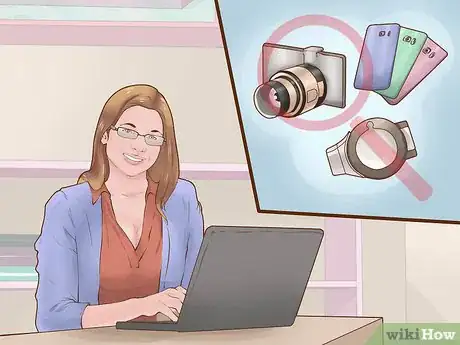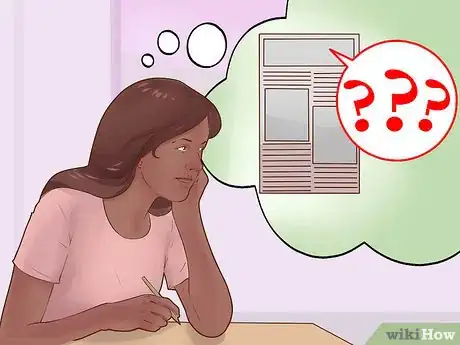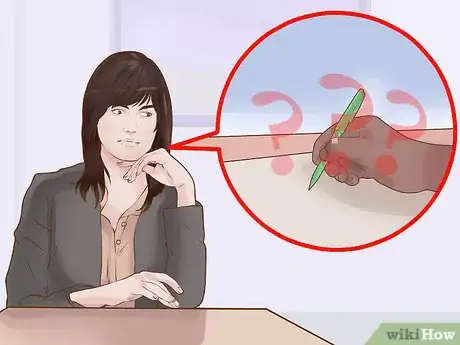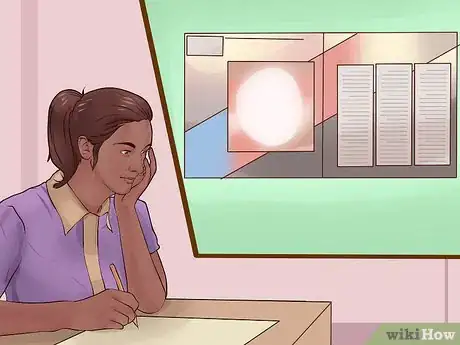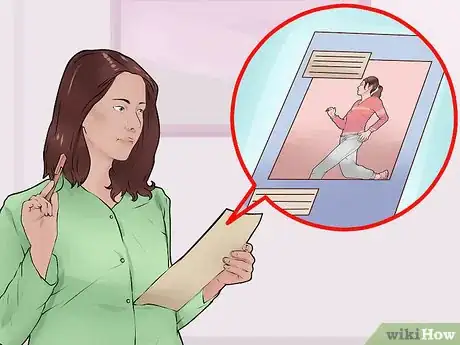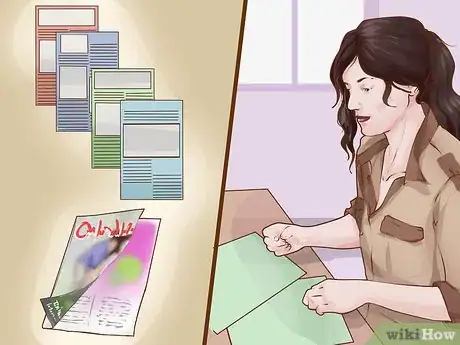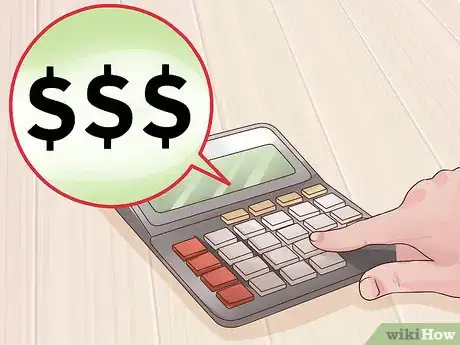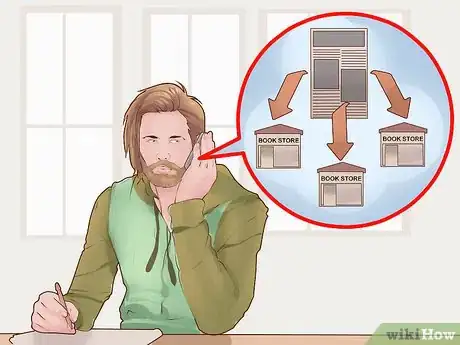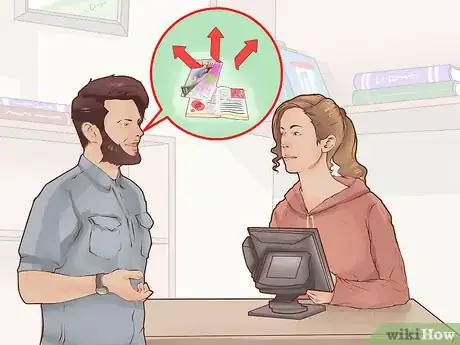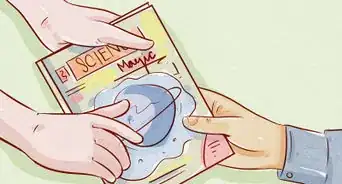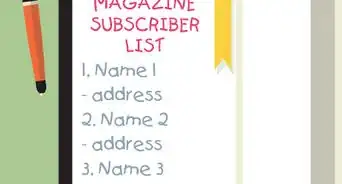This article was co-authored by wikiHow Staff. Our trained team of editors and researchers validate articles for accuracy and comprehensiveness. wikiHow's Content Management Team carefully monitors the work from our editorial staff to ensure that each article is backed by trusted research and meets our high quality standards.
This article has been viewed 127,858 times.
Learn more...
Magazines are a fun way to write about things you find important. Starting your own magazine, however, requires substantial work and effort. From start to finish, you should be considering what your magazine is about, how you will create content, where to publish your magazine, and how to circulate it. Whether you dream of big time success or small print glory, you can start your very own magazine with some time and dedication.
Steps
Brainstorming Your Magazine
-
1Choose a topic. Magazines usually have a theme or topic for all of their content. A good theme is general enough for you to write plenty on but specific enough that it caters to a specific audience. Some themes have more magazines than others, and you may want to break out into your own niche. As you come up with your theme, ask yourself:
- Is this an art or literary journal? A lifestyle journal? Is it about a certain hobby or fashion? Will I be reporting news or trends?
- Do other magazines cover this topic? How could I uniquely present this topic? What makes my idea different?
- What kinds of articles could I write for this magazine?
-
2Identify your target audience. You should determine what kind of person will be reading your magazine. By focusing on your audience, you will refine your magazine towards a specific niche.[1] Try to determine the following:
- Who would be interested in this topic?
- Am I marketing to a specific gender, age, religion, cultural background, or sexual orientation?
- Would people in certain industries or careers be more attracted to this type of magazine?
- What kinds of concerns does this audience have?
- How would this audience relate to my magazine?
- How often would I publish this magazine? Monthly? Weekly? Every two weeks?
Advertisement -
3Research your topic. Once you know what your theme is, it is good to do some research on it. You may already know the basics, but you should know what people expect of a magazine like yours. Research can help you generate ideas, and it will help you understand what to avoid in your niche.
- What are the most recent trends, fads, gadgets, apps, and fashions that relate to my topic?
- What kinds of articles do people need or want?
- What kind of tone do I need to set for this topic? Is it a highly technical subject? Can I use humor? Does it require high academic language or casual writing?
-
4Study similar magazines. The best kind of research you can do is to look at magazines that are similar to what you to do. While you should not steal their content, you can look for inspiration. These magazine can show you what does and does not work in a print medium. You can also find out if your idea has been done before or if the market is already saturated with that type of magazine.
- You can also contact the editors of these magazines to find out what printers they use, what their costs are, and how they sell advertisements.
-
5Define your mission statement. Write out a sentence or two that outlines what you want the purpose of your magazine to be. This statement should include who the targeted audience is and why they should read your magazine.
- For example, if you wanted to make a lifestyle magazine for young women interested in knitting, your mission statement could be: “This magazine seeks to explore the world of knitting for women 20-30 years old by fostering networks of creativity and offering the latest product reviews, fun and unique patterns, and monthly knitting contests.”
-
6Think of a title. The title should relate to your theme. It should be fun, catchy, and memorable. Good titles tend to be one to three words. It should clearly express what your magazine is about.
Creating Content for your Magazine
-
1Create a list of article ideas. Come up with as many ideas for articles, features, stories, and sections as possible. Aim for thirty to forty ideas, but come up with at least twenty articles. You may only use a couple of these in your first volume, but this will give you plenty of material for future issues. If you cannot come up with at least twenty ideas, you may want to refine your theme or topic.[2] Some ideas include:
- Top ten lists
- Product reviews
- Interviews
- Photo galleries
- News blurbs
-
2Assemble an editorial team. Making a magazine by yourself can be difficult. You can divide the workload by forming an editorial team that handles different parts of the magazine. You can ask friends or family members to help out. You can also advertise on a job board or through a local newspaper. Positions you can fill include:
- Editor-in-chief: the head of the entire magazine.The editor-in-chief approves each issue, comes up with issue ideas, and manages the business side of the magazine. You may want this position for yourself.
- Features editor: person in charge of the major story (or feature) of each issue. They come up with ideas, assign stories, and design the layout of the feature article.[3]
- Copy editor: the person who edits and proofreads all of your articles.
- Art director: person in charge of all art and media for each issue.
- Production manager: person who oversees the publication and printing of each issue.
-
3Find writers. It may be difficult to write all of the content yourself. Place a call for papers for your new magazine on social media, blogs, and in newspapers. You can also go to local writing conferences or post notices in coffee shops. Writers may contribute their own ideas based on the theme, or you can assign them a topic from your list of article ideas.[4]
- If you cannot pay your writers, be sure to advertise your magazine as an amateur magazine.
- If you can pay your writers, place the rate in your advertisement. Professional magazines typically pay about three cents per word.
-
4Write the articles. Make sure that your articles are of varying lengths. If this is your first magazine, you may want to start small with a short magazine of five to ten articles. Try having a variety of articles with one long article and several smaller snippets.
-
5Hire designers and artists to produce exciting new graphics. Magazines usually have plenty of visuals. These should be high resolution images that relate directly to the content that you provide. You can hire a photographer to scope out local events. You could also find a graphic designer to produce digital art. You could include cartoons, portraits, caricatures, or diagrams.
- You can hire freelancers by advertising on online job boards. You can also hire a design agency for your art.
- In addition to paying artists, you can buy stock photographs on the internet. Be careful, however, about lifting pictures from the internet without paying. You can be sued for copyright infringement if you do not have permission to use them.
-
6Organize the layout of your magazine. Decide how you want to arrange your text and images. You may choose to have a clean, white space for your articles, or you may fill the space with images. If you will be placing ads in your magazine, decide where you want them to go and how big they will be.
- Certain computer programs can help you design your layout, such as Adobe, Quark Xpress, Adobe PageMaker, Corel Ventura and Adobe FrameMaker.[5]
- Alternatively, you can hire a professional designer.
-
7Design a cover. Put fun colors and eye-catching pictures on the front cover. You can use an image from your main article or use a more general image that conveys the theme of your magazine. Place plenty of bold headlines to grab your readers’ attention.
- Use a legible font in big letters for your title. You may want to use a contrasting font for the smaller headlines.
- Choose a cover image that reflects the content of the issue.
Publishing Your Magazine
-
1Assemble a prototype. A prototype is an early sample of your magazine that will help you shop around your magazine to potential advertisers. It will also show your printer exactly how you want your magazine to look. Put together the different pieces that go together best. Make sure the pictures and articles match each other in tone and content. Print your prototype using a local printing service.[6]
- This is not the final copy of your magazine! After you visit advertisers, you will have to re-edit your magazine to include their ads, and you may make more changes during editing.
-
2Find advertisers. Advertisers are the primary source of funding for magazines. It may be difficult to find advertisers for a new magazine, but you can want to ask local small businesses if they would like to buy ad space in your new magazine.
- Bring your prototype with you as you meet with advertisers so they can see what kind of magazine you have.
- On average, most magazines are 50-60% advertisements, but you can include as many or as few advertisements you want based on how profitable you want the magazine to be. More advertisements will give you more money, but it may turn off readers who want more articles. Fewer advertisements give readers more content, but it makes your profits more dependent on subscribers. You do not want more than 70% of your space taken up by advertisements.[7]
-
3Contact printers. For a more professional looking magazine, you will want to work with a printer that specializes in magazines and periodicals. Many will have websites where you can upload your files. Local small scale printers may be able to do small runs while professional printers may have minimum print runs of 5,000 copies.
- You can contact magazines you enjoy to find their printers. Be aware that large magazines may hire more expensive printers.
- A local print shop may work for you if you want only a small run of about 100 copies or less.
-
4Calculate the costs. There are many different factors that determine the cost of printing. Before you print, you should consider what features you want your magazine to have. Ask potential printers for a quote for these features. These include:
- Will your magazine be in color or black and white?
- How many pages will it be?
- How many photographs and images are included?
- What kind of paper do you want it to be printed on?
Circulating Your Magazine
-
1Determine the cost of your magazine. Calculate all of your expenses. Be sure to include the operational expenses, the salary for your editorial board, payments to writers and artists, and printing costs. From this amount, subtract the money you made from advertisers. Divide this new number by the number of magazines you are circulating. This will give you an idea of what you might need to charge per magazine. Compare this cost to similar magazines, and tweak until you have a competitive price.
- Most magazines lose money on their first issue. Be aware that not all of your magazines will sell on their first run.
- Magazines typically charge less for subscriptions than they do for issues sold on the stand. Keep this in mind as you decide the cost of your magazine.
-
2Sell subscriptions. You can start by asking your friends and family if they would like to buy subscriptions. Advertise on social media, and ask blogs if they would be willing to advertise your new magazine.
- Advertise directly to your audience. If you know you have a targeted audience, find other publications and websites that they use, and place an advertisement there.
-
3Contact a distributor. If you have a large print run, you may want to invest in a distributor. Magazine distributors will sell your magazine directly to stores for you so that you do not have to handle the sale of thousands of magazines.
- Many distributors will not give you your earnings until the magazines have sold in stores. You will also have to pay them for each magazine sold. Consider the costs carefully.[8]
- Distributors are not suitable for small print runs. If you have a small run, you will need to handle distribution yourself.
-
4Ask local drugstores, bookstores, and shops to sell your magazine. You can distribute your magazines yourself by contacting local stores. Ask the managers or owners if they would willing to carry your magazine.
- They will want to know how much your magazine costs and how much they get to keep from each sale. Determine the cost of the magazine, and subtract the costs of printing, writing, and art per magazine. From that amount, negotiate how much money you will get to keep from each purchase.
-
5Create an online version. Most magazines have an online presence. An online version of your magazine will let potential readers access free articles to entice them to subscribe. It will also allow your articles to be shared on social media, which will give you free advertising. Consider whether or not you want to create a free version.
Community Q&A
-
QuestionIs it possible for a 14-year-old girl to publish a magazine?
 Community AnswerAnyone at any age can publish a magazine. You may not have access or money for some of the fancier features, but you can print your magazine using a home company or save up money to print it at a local print shop. Write what you know, and other 14-year-olds will love to read it.
Community AnswerAnyone at any age can publish a magazine. You may not have access or money for some of the fancier features, but you can print your magazine using a home company or save up money to print it at a local print shop. Write what you know, and other 14-year-olds will love to read it. -
QuestionHow to make a eye-catching magazine?
 Community AnswerAn eye-catching magazine will have intriguing and interesting graphics. Try coming up with a bold color scheme and a creative logo. Include plenty of full-color photographs. Make your fonts legible but interesting. You may even want to look into hiring a designer or artist to help design your layout. If you don't have the funding for it, you can use Photoshop to create your own designs.
Community AnswerAn eye-catching magazine will have intriguing and interesting graphics. Try coming up with a bold color scheme and a creative logo. Include plenty of full-color photographs. Make your fonts legible but interesting. You may even want to look into hiring a designer or artist to help design your layout. If you don't have the funding for it, you can use Photoshop to create your own designs. -
QuestionWhat is the minimum number of pages in a magazine?
 Community AnswerThere is no set minimum number of pages for a magazine. You should probably aim for at least five pages to ten pages, however.
Community AnswerThere is no set minimum number of pages for a magazine. You should probably aim for at least five pages to ten pages, however.
Warnings
- Don't publish any wrong or libelous information. You can be sued for printing lies.⧼thumbs_response⧽
- Be careful with borrowing money from family or friends to fund your magazine.⧼thumbs_response⧽
- Do not steal ideas, content, or images from other sources. In addition to being ethically wrong, this can get you in a lot of legal trouble, and it will lose you subscribers if it is revealed.⧼thumbs_response⧽
- Only one in ten magazines becomes profitable. Be extremely careful with your monetary investment if you choose to go this route.⧼thumbs_response⧽
References
- ↑ https://medium.com/swlh/how-to-start-a-magazine-f510f14566c5#.vir7o4qjf
- ↑ http://www.hongkiat.com/blog/creating-and-running-a-profitable-online-magazine-part-i/
- ↑ https://www.prospects.ac.uk/job-profiles/magazine-features-editor
- ↑ https://magazinescanada.ca/resource-centre/?fwp_categories=editorial
- ↑ https://magazinescanada.ca/resource-centre/?fwp_categories=production
- ↑ https://www.entrepreneur.com/article/160238
- ↑ https://magazinescanada.ca/resource-centre/?fwp_categories=editorial
- ↑ https://medium.com/swlh/how-to-start-a-magazine-f510f14566c5#.vir7o4qjf
About This Article
To create a magazine, make a list of potential articles for your magazine, including top 10s and product reviews. You should aim to have 5-10 articles which vary in length. Next, design a cover with eye-catching colors and pictures to grab readers' attention. Additionally, decide how you want to layout your magazine, including whether you want white space or pictures behind the articles. Then, assemble a prototype of your magazine so you can show printers and retailers how the finished product will look. For tips on how to find advertisers and how to calculate production costs for your magazine, read on!


